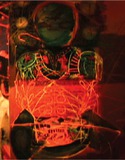Mostrar el registro sencillo del ítem
El dibujo y la pintura: "el conócete a ti mismo"
| dc.rights.license | http://creativecommons.org/licenses/by-nc-sa/3.0/ve/ | |
| dc.contributor.author | Arria Nucete, Maria Eugenia | |
| dc.date.accessioned | 2009-07-28T21:59:25Z | |
| dc.date.available | 2009-07-28T21:59:25Z | |
| dc.date.issued | 2009-07-28T21:59:25Z | |
| dc.identifier.issn | Revs-0002 | es_VE |
| dc.identifier.uri | http://www.saber.ula.ve/handle/123456789/29050 | |
| dc.description.abstract | Intentaremos mostrar la relación de dolor y placer en el arte, partiendo del dolor en Platón, y de las máximas “conócete a ti mismo” y “cuidado de sí”, porque el “conócete a ti mismo” es parte del proceso formativo. Según la teoría de la formatividad de Pareyson hay una dialéctica artistaforma-formante, es decir, el artista se forma a través de la ejecución de la obra. Es lo que llamamos “gnoseología de la interpretación”, donde el actuar humano es formativo. Las máximas “conócete a ti mismo” y el “cuidado de sí” constituyen, por otro lado, la manifestación de la humanidad del hombre, en este sentido, el concepto de alma y la interrelación entre placer y dolor competen al arte. Soportar el dolor y el comedimiento de los placeres hacen al hombre virtuoso; placer y dolor se convierten en uno. Desde esta visión, el dolor es importante en el proceso pedagógico y creativo, pues forma parte de la naturaleza humana. En Platón encontramos que el arte es un medio al servicio del bien y la verdad. De acuerdo con ello, el arte es la materialización del alma del creador, en otras palabras, la materialización de la idea a través del cuerpo y la materia. En el arte, el cuerpo es indispensable para que el alma del creador se manifieste. Con ello, se puede decir que el arte es un medio que nos puede permitir el conocimiento del mundo y de nosotros mismos. El arte como hermenéutica del “conócete a ti mismo”. | es_VE |
| dc.language.iso | es | es_VE |
| dc.rights | info:eu-repo/semantics/openAccess | |
| dc.subject | Formatividad | es_VE |
| dc.subject | Conocimiento | es_VE |
| dc.subject | Dolor | es_VE |
| dc.subject | Conócete a ti mismo | es_VE |
| dc.title | El dibujo y la pintura: "el conócete a ti mismo" | es_VE |
| dc.type | info:eu-repo/semantics/article | |
| dc.description.abstract1 | We will try to show the relationship between pain and pleasure in art, starting with the pain in Plato, and the maximum “Know yourself” and “self care” because “Know yourself” is part of the learning process. According to the theory of Format of Pareyson there is a dialectical formartist-formant, ie the artist is formed through the implementation of the work. This is what we call “epistemology of interpretation”, where human action is formative. The maximum “Know yourself” and “self care” are, moreover, the manifestation of man’s humanity, on the other hand, the manifestation of the humanity of man, in this sense, the concept of soul and the interrelationship between pleasure and pain involve art. Support the pain and control of the delights make men virtuous; pleasure and pain become one. From this vision, pain is important in the educational and creative process, as part of human nature. In Plato found that art is a resource for the good and truth. Accordingly, art is the embodiment of the soul of the creator, in other words, the materialization of the idea through the body and matter. In art, the body is essential to the soul of the creator becomes apparent. In so doing, we can say that art is an environment that allows knowledge of the world and ourselves. The art of hermeneutics as “Know yourself.” | es_VE |
| dc.description.colacion | 78-87 | es_VE |
| dc.description.frecuencia | semestral | es_VE |
| dc.identifier.depositolegal | 199702ME179 | es_VE |
| dc.subject.centroinvestigacion | Centro de Investigaciones Estéticas (CIE) | es_VE |
| dc.subject.facultad | Facultad de Humanidades y Educación | es_VE |
| dc.subject.keywords | Format | es_VE |
| dc.subject.keywords | Art | es_VE |
| dc.subject.keywords | Knowledge | es_VE |
| dc.subject.keywords | Pain | es_VE |
| dc.subject.keywords | Know yourself | es_VE |
| dc.subject.publicacionelectronica | Revista Estética | es_VE |
| dc.subject.thematiccategory | Artes y Humanidades | es_VE |
| dc.subject.tipo | Revistas | es_VE |
| dc.type.media | Texto | es_VE |
Ficheros en el ítem
Este ítem aparece en la(s) siguiente(s) colección(ones)
-
Estética - Nº 013
julio - diciembre 2008



